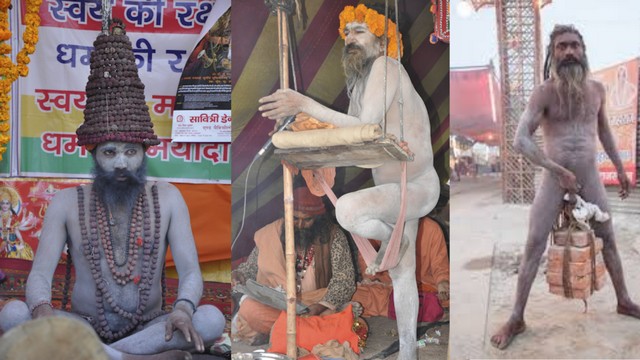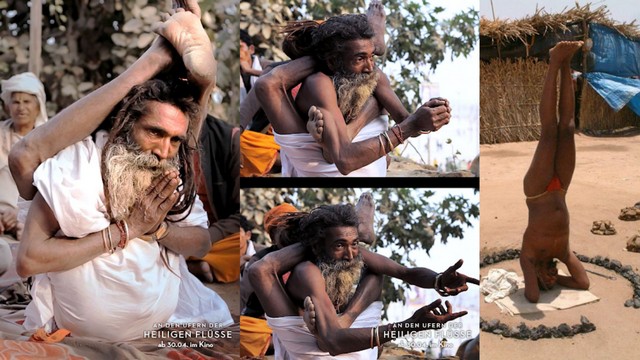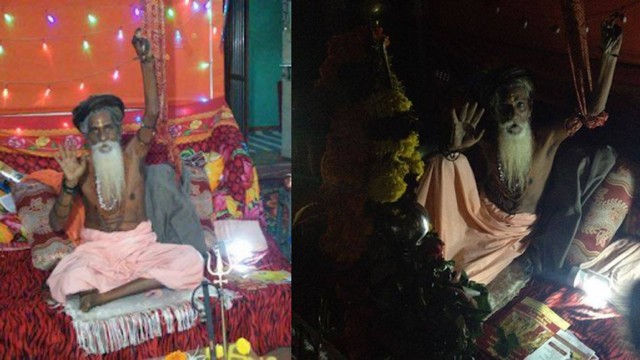The highlight event of the Kumbh Mela is the Shahi Snan – Royal bath. It is the ritualistic dip in the waters of the sacred river flowing in the holy city where the Kumbh Mela is being held. It is the Kshipra in Ujjain, the Sangam (confluence of Ganga, Yamuna and Saraswati) in Prayag, the Godavari in Nasik and the Ganga in Haridwar. The Naga Sadhus of the Akharas are covered with only sacred ash from head to foot. Naga – means naked. The spiritual practice of living without clothing symbolises the liberation from the delusionary material world and its bondages.
The Sadhus display their lifelong austerities and unimaginable yogic feats during the Kumbh Mela. Sadhus such as the Urdhwavahurs put their bodies through severe austerities, the Parivrajaka Sadhus take a vow of lifelong silence and alert others of their presence through ringing a bell, the Shirshasin Sadhus who stand all 24 hours on their heads and meditate, the Kalpvasis who bathe thrice a day as an austerity. The Kumbh Mela is a splendorous display of the different sects of saints, vairagis (the austere ones), and yogis who have renounced the material world.
Apart from them, one can also see sadhus performing impossible acts such as penance while sitting on a treetop, lifting of one hand hand in the air for 20 years continuously, lifting of one leg and functioning with the support of the other leg for years together, folding of the legs and functioning in that posture for years together, burying the head beneath the ground and continuing to breathe through intake of prana (life energy) through the skin instead of using air as a carrier and breathing through only the nose and many more.

(left) A Sadhu who stood on one leg for ten years. (Photo: Laura Spinney); (centre) Lakshman Giri is famous for his crown of the sacred rudraksh seeds that he has worn for 16 years. (right) Similarly, a Sadhu lifting bricks with his genitalia.

A sadhu who has developed the yogic power of being able to pull an entire tractor with his Genitalia – a power developed after years of penance and Brahmacharya (celibacy)

(left)“Hatha Yoga baba” at the Ujjain Kumbha Mela, 2016. He is able to retain this yogic posture for extended hours at a time. A Sadhu performing Shirsasana (head-stand) – a position that he is able to hold for many hours.(right)

A Sadhu who has had his hand raised for several years as penance.
Darshana, or auspicious sight, is an important part of the Kumbh Mela. People make the pilgrimage to the Kumbh Mela specifically to see and experience the religious and spiritual fervor of India and its ascetic communities. The two groups of people that converge in the Kumbh Mela include the Sadhus and the pilgrims. The Sadhus travel to the Kumbh Mela to make themselves available for the pilgrims. The Kumbh Mela is arranged in camps that give the pilgrims access and “darshana” of the Sadhus. Through their powerful yogic practices, the Sadhus articulate the transitory aspect of life. The pilgrims are able to “seek instruction or advice in their spiritual lives.” The darshana is an important experience at the Kumbh Mela as it reminds and steers one towards one’s own original purpose of life which is enlightenment.
After the Royal Bath, people visit the temples situated on the banks of the river or near by places.
The Kumbh Mela is the place where for tens of thousand of years both the Shāstradharis (those who are well versed in the scriptures – the intelligentsia) and the Shastradhaaris (bearers of weapons) meet, celebrate and uphold the spiritual teachings.
The Kumbh Mela begins with the immersion of the Kumbh (urn) containing Kapila Mahamuni’s skull into the sacred waters of the Prayagraj (confluence of the three sacred rivers namely Ganga, Yamuna and Saraswati). In his memory and living presence, the followers of Hinduism celebrate every twelves years, the liberation that is enlightenment – Nirvāṇa, through the Kumbh Mela festival.
Types of Kumbh Mela
The Kumbh Melas which follow the Hindu calendar, are classified as:
- The Kumbh Mela that happens every 12 years at a given site is called the poorna Kumbh Mela. The Kumbh Mela at Allahabad is celebrated approximately 3 years after Kumbh at Haridwar and 3 years before Kumbh at Nashik and Ujjain (both of which are celebrated in the same year or one year apart).
- Ardh Kumbh (“Half Kumbh”) Mela occurs every 6 years between the two Purna kumbh Melas at Allahabad and Haridwar.
- The Maha Kumbh occurs after 12 Purna Kumbh Melas i.e. every 144 years.

Mystical and Powerful Ascetics Seen at Kumbha Mela
